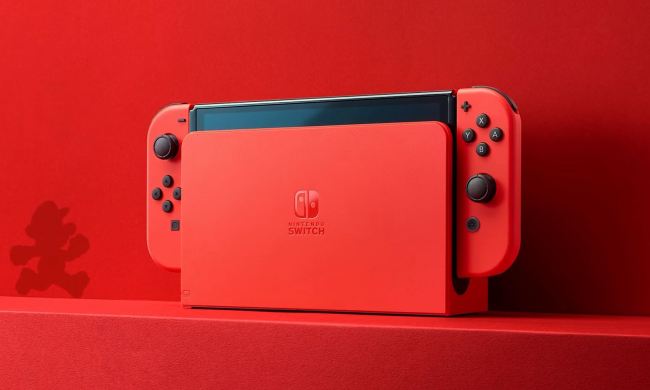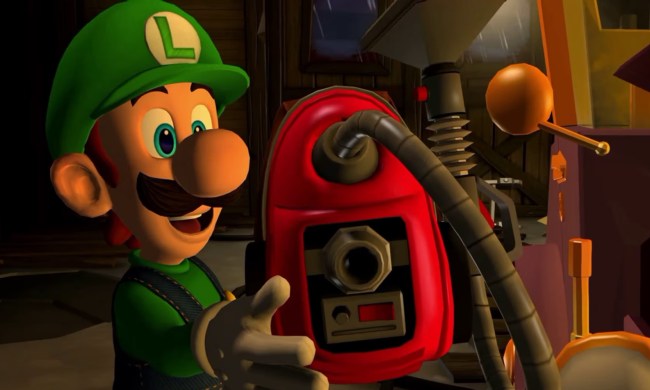Metroid Dread is scary. While it won’t permanently scar any seasoned horror veterans, it’s certainly the most unsettling Nintendo game ever made. It features tense chase scenes, boss battles against grotesque monsters, and some late game twists that are genuinely unnerving. Those who need a suitably creepy game for the spooky season can’t go wrong here.
The game’s use of horror differs from other titles in the genre. It never stoops to jump scares, instead finding different ways to create a sense of, well, dread. It’s built on paranoia as Samus is at times helpless against nearly unstoppable foes. At its best moments, Metroid Dread is an effective psychological horror experience that understands how to stack the odds against players even as they’re powering up. It does make some missteps in other moments, reminding us of the limits of video games as a horror medium.
We’ll be taking a deep dive into the ending of Metroid Dread in this article, so turn away if you don’t want it spoiled.
Creating consequences
A common horror philosophy is that a story should start with the worst thing that could happen. You’ll often see slasher flicks opening with the grizzliest murder possible as unaware teens who never stood a chance are sliced up. It creates an immediate threat u front, showing viewers just how high the stakes will be for their heroes.
Metroid Dread only gets that equation half-right, which starts the game on a weird foot. Like most Metroid games, we open with a sort of “all hope is lost moment.” Samus lands on the mysterious Planet ZDR and is attacked by a powerful Chozo creature. It wipes the floor with her, destroying her suit’s powers and trapping her in the deepest reaches of the planet. It checks all the boxes for a good horror story. By inverting the series’ usual “explore a planet” formula into an escape narrative, we begin with Samus at her most vulnerable.

That sets us up for our first encounter with the E.M.M.I., a batch of creeping, killer robots that can only be destroyed with a specific, high-powered weapon. On paper, the E.M.M.I. should be terrifying — and they are at times. When Samus enters a robot’s patrol zone, they stalk her by snaking around platforms. Each one is faster and smarter than the last, making for some tense games of cat and mouse. These are sequences that feel especially perfect in the age of content creators who are eager to get a good clip of themselves shrieking as they play.
But the E.M.M.I. are a mixed success as a horror tool, which speaks to a tricky situation in video games at large. For one, Metroid Dread makes an immediate mistake by showing players how to safely destroy a robot before they can even get chased by one. Samus slides under her first attacker’s metal legs, climbs up a wall, grabs a gun and blasts it away. It’s hard to be too scared of a foe after taking it out in two minutes flat, but Dread has to balance terror with tutorial.
Getting caught by a robot is more frightening. Players have a split-second opportunity to counterattack an E.M.M.I. and wriggle out of its grasp. It’s extremely hard to pull off and more often than not will result in failure. When players mess up, they watch as a robot violently (but bloodlessly) jabs a metal needle into Samus’ helmet.

The problem is that it’s not much of a setback for Samus. She’ll just respawn back at the start of the E.M.M.I. zone (Dread doesn’t even kick you back to your last save point like older Metroid games). If a character gets caught by a killer in a horror movie, that’s probably the last time you’ll see them alive. Seeing a character that we care about, or are otherwise invested in, permanently die lends noninteractive media high stakes. But the show must go on in a video game. How unsatisfying — and frustrating — would it be if Samus actually died there? It’s just not feasible, which makes death a sometimes hollow threat in games.
There isn’t a great way around that problem. Unless a game adopts a high-concept idea (like the “permadeath” threat in Hellblade: Senua’s Sacrifice), the hero will always respawn unharmed. The consequence is little more than a one-minute rewind in Dread, taking some bite out of an otherwise tense setup.
Loss of self
If the threat of death is rarely permanent in a horror game, can the genre really create lasting scares? Metroid Dread answers its own question in its second half, which de-emphasizes the E.M.M.I. in favor of something much more distressing. At the midway point, Samus travels to the temple-like Elun and makes a horrifying discovery: The shape-shifting X parasites are thriving here. We’re treated to a series of nightmares as parasite-ridden enemies begin transforming into greasy, black creatures all around the screen. After beating Elun’s boss (an infected Chozo knight with a horrifying head), we get a haunting visual as X parasites start to spill out of the temple. Adam soon informs Samus that every creature on ZDR has likely been infected. That’s how fast and dangerous these blobs are.
The back half of the game feels different. ZDR’s entire ecosystem has been destroyed by an invasive species that has essentially possessed all life. Fights become more erratic, which raises the tension. In one room, Samus shoots a standard four-legged enemy as she’s done dozens of times in her journey. It morphs into a parasite and reforms as a stronger variant. She kills it again and it builds back even stronger. No creature is in control of its own body anymore.
The real scary thing about Dread isn’t death; it’s a total loss of self. The X parasites are more of an existential threat as they can turn any living being into a brainless weapon against their will. Suddenly, dying feels like the easy way out. Samus would be so lucky.
Those themes come to a head in the game’s most shocking twist: Samus is turning into a Metroid, the very species she spent several games fighting against. A late game reveal explains that lifesaving Metroid DNA she received in Metroid Fusion has started to take over her body. We see it happen via several cutscenes where Samus seemingly sucks the energy out of her foes just like a Metroid would. In one sequence, a monster attacks and her instincts kick in … but not her human ones. She turns around and nearly sucks the life out of it with her hand. She freezes in horror, perhaps realizing that she has nearly lost control of herself, before blasting it away with her arm cannon. Samus’ very body is split, with her hands representing the DNA clashing within her. She’s Jeff Goldblum in David Cronenberg’s The Fly, torn between human and monster — a real Brundlefly situation.
Dread’s narrative crescendo makes that comparison stick even more. After a climactic battle against Raven Beak, Samus’ survival instincts push her over the edge. Her entire body undergoes a full transformation as her metal suit is replaced by a grotesque, fleshy one that resembles a Metroid. The worst thing that could happen to Samus happens: She has become the last living member of a species she wiped out. Her reckless past claims her identity, just like an X parasite that hijacks other creatures. She’s alive, but haunted like an Edgar Allen Poe character at the heart of a cautionary tale.

Naturally, everything goes well for Samus in the end (this is a Nintendo game, after all). Her body is restored to normal just before the credits roll and she goes on to fight another day. That doesn’t lessen the impact of Metroid Dread’s horror, though. Two weeks after finishing the game, its images still stick in my mind. I can’t stop thinking about Samus draped in a suit of the same flesh and talons she recklessly blasted away in Metroid 2. Death is a minor inconvenience in Metroid Dread, but being forced to live consumed by the consequences of our actions is the real terror.
Metroid Dread is out now on Nintendo Switch.



